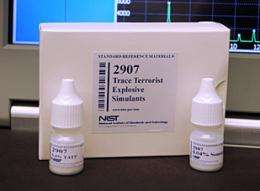New NIST SRM supports the fight against terrorist bombings

The National Institute of Standards and Technology (NIST) has released a new standard reference material (SRM) to aid in the detection of two explosive compounds that are known to be used by terrorists. Researchers designed the new test samples to simulate the size and behavior of residues that remain after handling the explosives PETN (pentaerythritol tetranitrate) and TATP (triacetone triperoxide). Instrument developers, academic researchers and government labs can use the SRM to test, refine and validate their new detector designs.
The new test samples are available from NIST as Standard Reference Material (SRM) 2907, "Trace Terrorist Explosives Simulants."
Fabricating and handling explosives leaves trace residues of the explosives on skin, clothes or other possessions. These residues are invisible to the naked eye and difficult to remove but may be detected by sensitive explosives detectors. Airport security personnel collect residues with handheld swipe wands. The swipes are then heated to vaporize the explosives, and the vapors analyzed in a tabletop detector. Current detectors typically use a technique called ion mobility mass spectrometry that can recognize specific ionized chemicals based on their chemical properties.
Both PETN and TATP are relatively difficult to detect in the field. The compounds were used in failed terrorist attacks by the "shoe bomber" in 2002 and the "underwear bomber" in 2009.
The new NIST reference material contains meticulously measured concentrations of these two explosives that can be used to test and validate the ability of machines and methods to detect the explosives' presence. The SRM is not itself explosive; it is formulated from inert particles coated with a trace amount of the two explosives.
NIST researchers certified the PETN and TATP content of the simulants using liquid chromatography with both ultraviolet absorbance and mass spectrometric detection. Analytical challenges included development of a new ionization-enhancing additive (for PETN) and a custom synthesized stable-isotope internal standard for the liquid chromatography mass spectrometer measurements of TATP. Details of the development of the materials and the analytical methods used were described in a 2011 paper in Analytical Chemistry.
SRM 2907, Trace Terrorist Explosives Simulants, is the third SRM supporting the detection of trace explosives. Details, including pricing and distribution, are available at www-s.nist.gov/srmors/view_detail.cfm?srm=2907 . The Department of Homeland Security Science and Technology Directorate funded the production of the work presented in this material under HSHQDC-10-00297 with NIST.
Standard reference materials are among the most widely distributed and used products from NIST. The agency prepares, analyzes and distributes about 1,300 different materials used throughout the world to check the accuracy of instruments, validate test procedures, and serve as the basis for quality control standards worldwide.
More information: W. MacCrehan, et al. Development of SRM 2907 trace terrorist explosives simulants for the detection of semtex and triacetone triperoxide. Anal. Chem., 2011, 83 (23), pp 9054–9059. Oct. 17, 2011 DOI: 10.1021/ac201967m
Journal information: Analytical Chemistry
Provided by National Institute of Standards and Technology



















